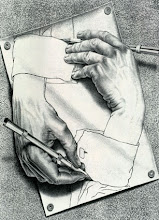Note: Labels are a necessary evil in relationships. This post concentrates on just the evil part.
Let
us consider a person A. I will denote him/her with a circle enclosing a set of
points which represent characteristics that can be used to define the person A.
For example
Now the same for another person B
What typically gets two people
close? It’s the similarities and NOT the dissimilarities. So in this case when
A and B get close, it is usually due to common factors such as “Good looking”
and “ABC”. Now, let us represent their relationship.
Once A and B are happy about the
intersection, they give a label to the relationship (boyfriend-girlfriend for
example). This is where the problems start. Once a label is given, there are
certain societal/self-made norms which consciously/subconsciously start influencing
the relationship. Say A is a girl and B is a boy. But societal norms dictate
that men should be career driven. This can (statistically speaking) make A
uncomfortable and start to convert the career point of B such that in can be
dragged to the area of intersection and thereby increasing the area of
intersection (below figure)
This is one of the main problems
in relationships. The following are the issues with this model of functioning.
-
Firstly, even if A has managed to convert the
point of interest, if it has happened against the will of B or if B is not
adequately convinced that he should convert, the conversion is a FLASE
conversion.
-
This is not helpful for A because she is under
the illusion that the area of intersection has increased while in reality it
has not. Further, if more and more such unwilling conversion takes place, B is
consciously/sub consciously counting that the relationship’s cost to benefit ratio
is not favorable.
-
This is not helpful for B because he is forced
to act against his will which will negatively affect the way he sees the
relationship.
In the light of the above issues,
I propose the following modification.
Let there be NO FORCED
INTERSECTION WHATSOEVER. However, A can discuss with B about why she thinks
certain points are worth converting (with justification) and leave B to decide.
This is equally applicable to B for issues where B feels A should convert. B
can discuss and leave it for A to convert if she wishes so. This can lead to 2
outcomes and in my option both are better than the outcomes when there is a
forced conversion.
-
A or B can actually get convinced and willfully
convert. This is a GENUINE increase of the area of intersection and so good for
both the parties. Or sometimes, one of the parties is not rationally convinced
but emotionally feels the need to change for the other person. Here also it is willful
conversion and so benefit outweighs the cost.
-
Say the area of intersection never increase (or
worse it can also decrease with time). Then, each party can evaluate whether
the intersection is good enough for them to continue in the relationship. If
so, well and good. Else, breaking up is good for both the parties.
In conclusion – Everyone wants
the area of intersection to increase. But if it is forced, it is not only not
increasing, it usually decreases. The ‘means’ are as important as the ‘end’. If
we are propelled only by the ‘end’, we are setting up ourselves for a disaster.
P S : Selfishness is not as one wishes to live,it is asking others to live as one wishes to live - Oscar Wilde
P S : Selfishness is not as one wishes to live,it is asking others to live as one wishes to live - Oscar Wilde
